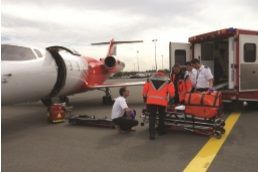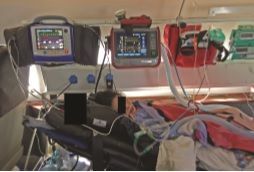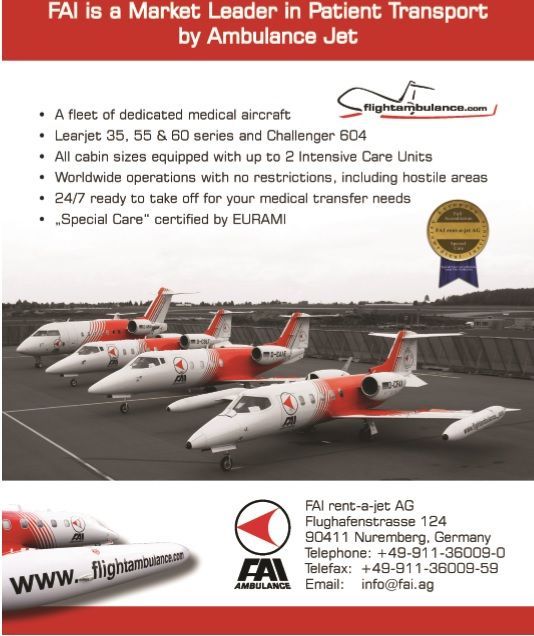Interview with Georg Keunecke of FAI rent-a-jet AG on the global use of the
HAMILTON-T1 as an ICU transport ventilator.






Georg Keunecke is the Chief Flight Paramedic and Representative for Medical Devices with FAI rent-a-jet AG (dba Flight Ambulance International). Headquartered at the Nuremberg International Airport, the company serves a wide range of customers in the air ambulance sector. Six jets are available for ambulance flights around the world which make up about two thirds of all missions. In some cases, insurance companies commission FAI to bring their injured customers back home. On other occasions, FAI operates on behalf of governments or Non-Governmental Organizations (NGOs), sometimes as a service provider to the United Nations.
Just as the destinations are diverse, so is the range of medical emergencies. FAI transports patients with all kinds of injuries and illnesses, including sports injuries, tropical diseases, burns and preterm births, to name a few.
“It is extremely important for us to have a fully featured ICU transport ventilator at hand.”

Q: How does your job differ from that of an intensive care nurse in a hospital?
Keunecke: On the one hand, the changing environment poses a challenge. Since we operate all over the world, we have to adjust to many different conditions. This applies not only to the climate, but also to the working environment in foreign hospitals where we pick up or deliver our patients.
On the other hand, resources on board are limited. They call us a mobile ICU, but naturally resources such as oxygen, power and drug supplies are limited, along with access to diagnostic tools.
Q: How can the HAMILTON-T1 support you with these challenges?
It is extremely important for us to have a fully featured ICU transport ventilator at hand which at the same time is transportable. In other words, not too heavy, not too big, and resistant to environmental conditions. The HAMILTON-T1 is an extremely robust device. This is a huge advantage for us since we can employ it in various temperature ranges and environments.
The HAMILTON-T1 can stand a few drops of rain whenever we have to load or unload the patient outside the aircraft under the wings. What really helps us especially during long transports is the extended battery life.
Q: For what patient groups do you use the HAMILTON-T1?
With our previous ventilators, we could only transport patients with a minimum weight of 1000 grams (2.2 lbs). Thanks to the HAMILTON-T1, we can now provide sufficient ventilation also to premature infants, allowing us to ventilate the entire range of patients from premature infants to adults using the same device.
Less time spent on logistics and more user safety
Q: Why is that an advantage for you?
This offers multiple advantages. For one, it offers a huge logistical advantage since we no longer have to pass by the home base in Nuremberg to exchange
the ventilator whenever transport of an adult patient is followed by transporting an infant. Thanks to the HAMILTON-T1 we can ventilate all patients and are spared this logistical effort.
Another great benefit is user safety. We don't have to familiarize ourselves with a different device each time. Our paramedics and nurses are trained on this device and use it regularly, which provides routine practice and safety.
“A relatively simple and intuitive device”

Q: Was the training on the HAMILTON-T1 challenging?
Training was not any more challenging than on our old device because the HAMILTON-T1 is simple and intuitive in its operation. It is also works to our advantage that all Hamilton Medical ventilators are very similar and many of our colleagues already use them in the hospital.
Thus they could get started with the HAMILTON-T1 right away since they were already familiar with how to operate it.

Q: How would you summarize your personal experiences with the HAMILTON-T1?
I have collected positive experiences with it throughout. The device is easy to use and absolutely reliable without any failures. This allows us to focus on the patient, especially during handovers of critical patients, because we can rely on the device performing its tasks.


Latest Articles
HamiltonMedical, ventilation, air ambulance, Transportation, FAI
Interview with Georg Keunecke of FAI rent-a-jet AG on the global use of the HAMILTON-T1 as an ICU transport ventilator. Georg Keunecke is the Chief Flight...






















